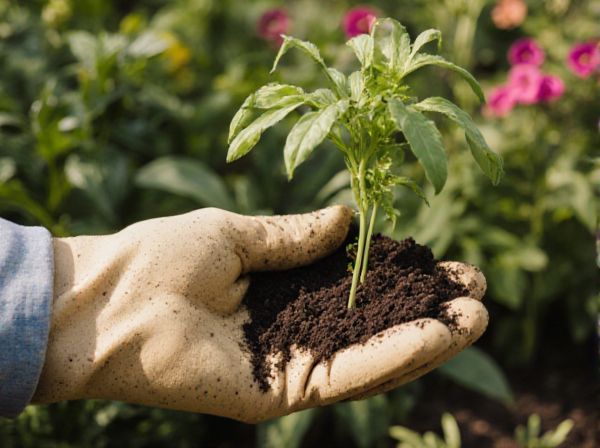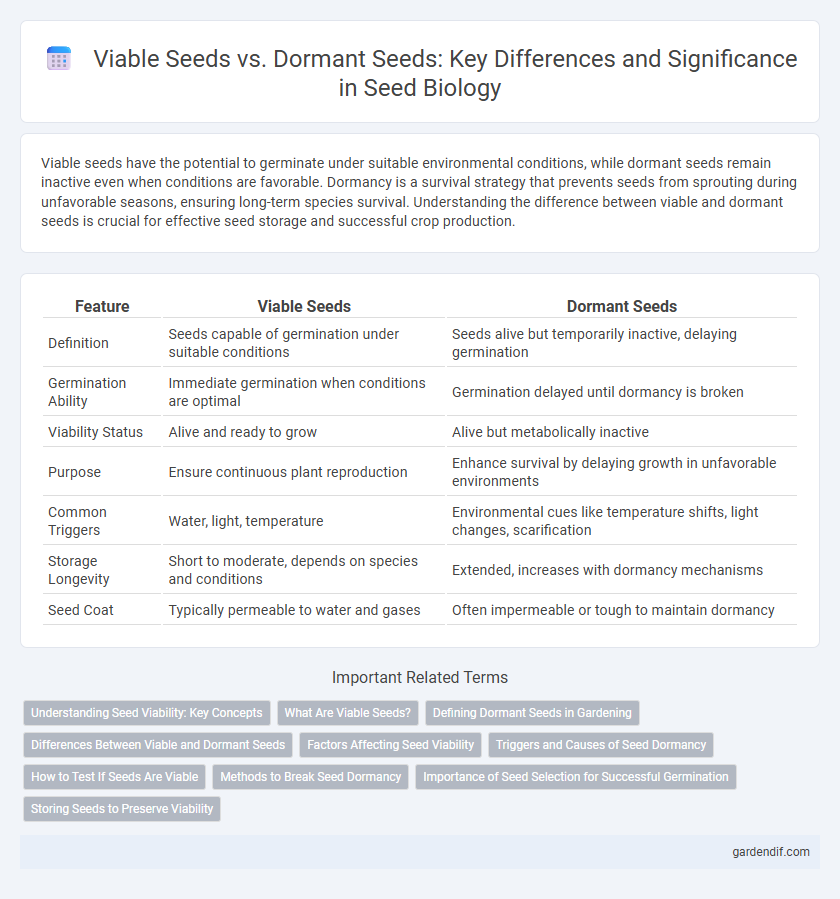
Viable seeds vs Dormant seeds Illustration
Viable seeds have the potential to germinate under suitable environmental conditions, while dormant seeds remain inactive even when conditions are favorable. Dormancy is a survival strategy that prevents seeds from sprouting during unfavorable seasons, ensuring long-term species survival. Understanding the difference between viable and dormant seeds is crucial for effective seed storage and successful crop production.
Table of Comparison
| Feature | Viable Seeds | Dormant Seeds |
|---|---|---|
| Definition | Seeds capable of germination under suitable conditions | Seeds alive but temporarily inactive, delaying germination |
| Germination Ability | Immediate germination when conditions are optimal | Germination delayed until dormancy is broken |
| Viability Status | Alive and ready to grow | Alive but metabolically inactive |
| Purpose | Ensure continuous plant reproduction | Enhance survival by delaying growth in unfavorable environments |
| Common Triggers | Water, light, temperature | Environmental cues like temperature shifts, light changes, scarification |
| Storage Longevity | Short to moderate, depends on species and conditions | Extended, increases with dormancy mechanisms |
| Seed Coat | Typically permeable to water and gases | Often impermeable or tough to maintain dormancy |
Understanding Seed Viability: Key Concepts
Viable seeds possess the necessary live embryonic tissues and sufficient nutrient reserves to germinate under favorable environmental conditions. Dormant seeds, although alive, contain physiological or morphological inhibitors that prevent germination until specific external cues or internal changes trigger viability activation. Assessing seed viability involves techniques such as tetrazolium testing and germination trials to differentiate dormant seeds from non-viable ones, ensuring accurate predictions for successful crop establishment.
What Are Viable Seeds?
Viable seeds contain living embryos capable of germination under suitable conditions, ensuring successful plant growth and reproduction. These seeds maintain essential physiological functions such as moisture content, enzyme activity, and nutrient availability that support seedling development. Testing methods like the tetrazolium test and germination trials accurately determine seed viability for agricultural and horticultural purposes.
Defining Dormant Seeds in Gardening
Dormant seeds are viable seeds in a temporary state of suspended growth, requiring specific environmental cues such as temperature changes, light exposure, or moisture to break dormancy and initiate germination. Unlike viable seeds that germinate readily under favorable conditions, dormant seeds possess physiological or physical barriers preventing immediate sprouting, ensuring survival through adverse periods. Understanding seed dormancy is crucial for gardeners to optimize seed treatment methods like stratification or scarification to enhance germination success rates.
Differences Between Viable and Dormant Seeds
Viable seeds contain living embryos capable of germination under favorable conditions, while dormant seeds are alive but temporarily unable to germinate until dormancy-breaking requirements are met. Viability is confirmed through germination tests or tetrazolium staining, indicating metabolic activity, whereas dormancy involves physiological or physical inhibitors that delay germination. Understanding these differences is crucial for seed storage, agricultural planning, and maximizing crop yields.
Factors Affecting Seed Viability
Seed viability is influenced by factors such as moisture content, temperature, and storage conditions, with optimal moisture levels typically below 12% to prevent fungal growth and metabolic deterioration. Exposure to extreme temperatures or fluctuating humidity can reduce viability by accelerating aging and enzyme inactivation in viable seeds. Genetic factors and seed coat integrity also play crucial roles in maintaining dormancy and preventing premature germination, ensuring that dormant seeds remain viable until favorable conditions arise.
Triggers and Causes of Seed Dormancy
Viable seeds contain living embryos capable of germination under favorable conditions, whereas dormant seeds remain alive but inactive due to physiological or physical barriers. Seed dormancy is primarily triggered by factors such as impermeable seed coats, hormone imbalances like high abscisic acid levels, and environmental cues including temperature fluctuations or light exposure. These mechanisms ensure seeds delay germination until conditions optimize seedling survival and growth.
How to Test If Seeds Are Viable
Testing seed viability involves a simple germination test by placing seeds on a moist paper towel inside a plastic bag and keeping them in a warm, dark place for several days. Viable seeds will typically sprout within this period, indicating their potential to grow into healthy plants. Dormant seeds that fail to germinate may require specific treatments like stratification or scarification to break dormancy and improve viability.
Methods to Break Seed Dormancy
Viable seeds contain a living embryo capable of germination under suitable conditions, while dormant seeds require specific environmental triggers to resume growth. Methods to break seed dormancy include scarification, stratification, and exposure to chemical treatments like gibberellic acid, which simulate natural processes that soften seed coats or signal favorable growth conditions. These techniques enhance germination rates by overcoming physical, physiological, or morphological barriers inherent in dormant seeds.
Importance of Seed Selection for Successful Germination
Selecting viable seeds is crucial for successful germination, as they contain the necessary nutrients and fully developed embryos to initiate growth under suitable conditions. Dormant seeds, although alive, require specific triggers such as temperature changes or scarification to break their dormancy and begin germination, which can delay or reduce germination rates if not properly managed. Careful seed selection based on viability tests like float tests or germination assays enhances crop yield and ensures efficient use of resources.
Storing Seeds to Preserve Viability
Storing seeds to preserve viability requires controlling temperature, humidity, and light exposure, with cool, dry, and dark conditions being optimal to prevent premature germination or degradation. Viable seeds maintain their metabolic functions to germinate when conditions are favorable, whereas dormant seeds have inhibited germination despite being viable, often requiring specific treatments like stratification or scarification to break dormancy. Proper storage methods, such as sealed containers with desiccants in refrigeration, significantly extend seed longevity by minimizing moisture and microbial activity.
Viable seeds vs Dormant seeds Infographic

 gardendif.com
gardendif.com